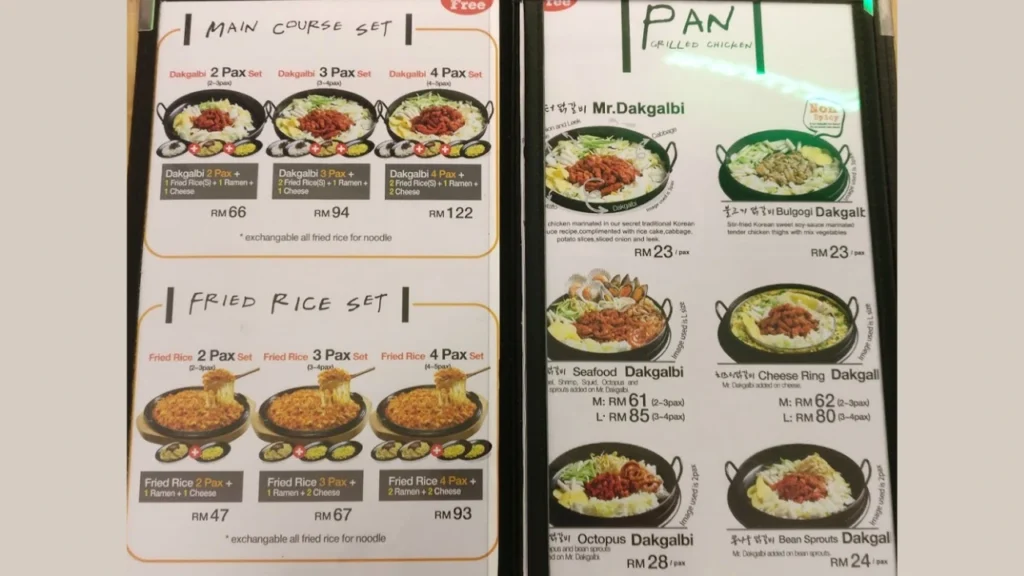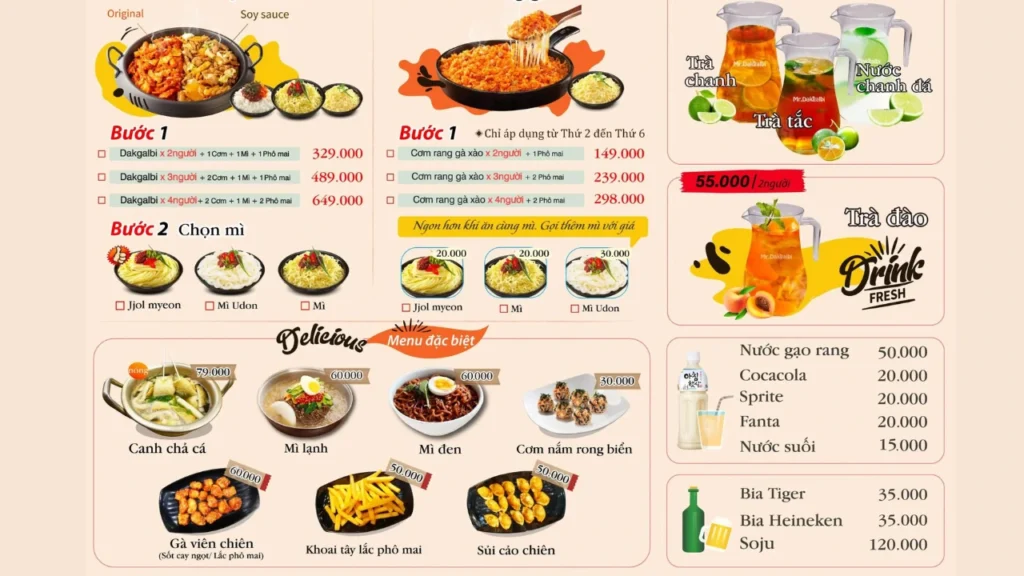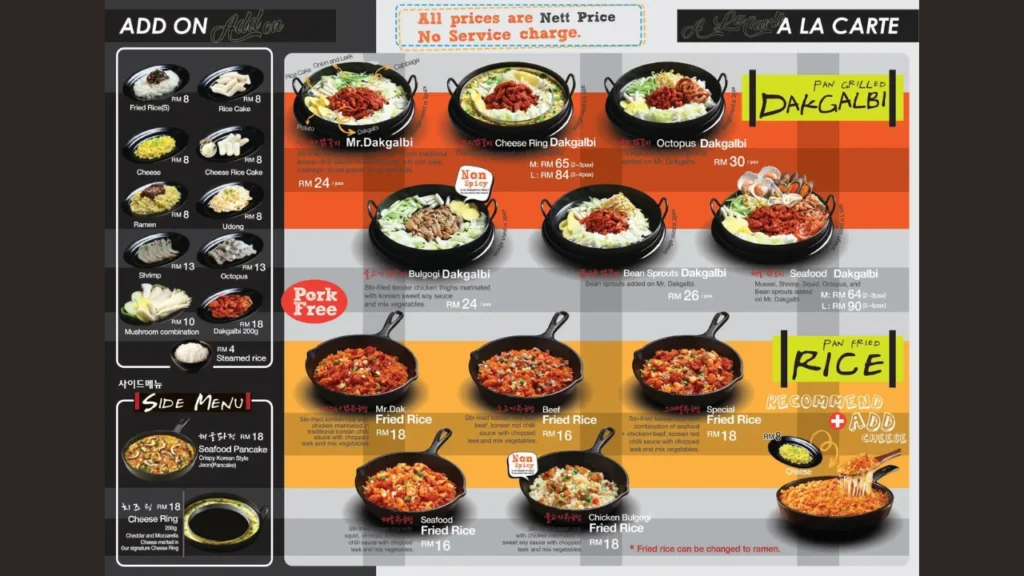The Dakgalbi menu is a well-loved Korean culinary offering that captivates food enthusiasts with its bold flavors and dynamic variety. Originating from Chuncheon in South Korea, dakgalbi has evolved from a humble street food to a popular dining experience worldwide. This article explores the rich diversity found within the menu, uncovering the ingredients, variations, and traditions behind this iconic dish.
What Makes Dakgalbi So Special?
Dakgalbi is known for its spicy stir-fried chicken, marinated in a blend of Korean chili paste (gochujang) with garlic, soy sauce, and sugar. Traditionally cooked on a large, flat iron pan at the center of the table, dakgalbi is a communal dish where guests enjoy cooking and eating together. This vibrant dish often includes vegetables like cabbage, onions, and sweet potatoes, accompanied by rice cakes (tteok) or noodles. The Dakgalbi menu offers variations that cater to different spice levels and taste preferences, making it suitable for everyone.
Detailed Menu

| Dish | Description | Key Ingredients | Spice Level | Suggested Add-Ons |
|---|---|---|---|---|
| Classic Spicy Dakgalbi | Traditional dakgalbi with gochujang marinade | Chicken, cabbage, onions, tteok, sweet potato | 🔥🔥🔥 | Ramen, cheese, kimchi |
| Cheese Dakgalbi | Dakgalbi topped with melted cheese | Chicken, cabbage, gochujang, mozzarella | 🔥🔥 | Extra cheese, sweet corn |
| Seafood Dakgalbi | Spicy stir-fried chicken with seafood twist | Shrimp, squid, chicken, mushrooms | 🔥🔥🔥 | Udon noodles, vegetables |
| Soy Sauce Dakgalbi | A milder version with soy-based marinade | Chicken, mushrooms, zucchini, onions | 🔥 | Boiled egg, green onions |
| Dakgalbi Fried Rice | Leftover sauce stir-fried with rice | Rice, chicken, seaweed flakes, vegetables | 🔥🔥🔥 | Kimchi, extra seaweed |
| Sweet Corn Side Dish | A sweet-savory corn dish with cheese topping | Sweet corn, mayonnaise, melted cheese | 🌶️ None | Cheese, extra mayo |
Popular Variations

The versatility of the Dakgalbi menu makes it appealing to a wide range of tastes. Restaurants often provide customizable options, allowing customers to add ingredients like seafood, cheese, or extra rice cakes. A classic dakgalbi dish is spicy, but there are non-spicy alternatives as well for those seeking milder flavors.
| Type of Dakgalbi | Description | Common Ingredients |
|---|---|---|
| Classic Spicy Dakgalbi | Stir-fried chicken with gochujang-based marinade. | Chicken, cabbage, tteok, onions, sweet potatoes |
| Cheese Dakgalbi | Topped with melted cheese for a creamy, spicy twist. | Mozzarella, chicken, cabbage, gochujang sauce |
| Seafood Dakgalbi | Incorporates shrimp, squid, or octopus for a fusion of flavors. | Seafood, chicken, mushrooms, onions |
| Soy Sauce Dakgalbi | A milder version using a soy sauce marinade. | Chicken, zucchini, mushrooms, soy sauce |
| Dakgalbi Fried Rice | Leftover sauce and ingredients stir-fried with rice at the end of the meal. | Rice, nori flakes, vegetables |
Ingredients that Define
The base ingredients for a classic dakgalbi dish include chicken thighs, cabbage, onions, and gochujang. These ingredients are then enhanced with customizable elements that elevate the dining experience. For instance, adding rice cakes gives the dish a chewy texture, while sweet potatoes provide a hint of sweetness that balances the spice. Many restaurants also offer additional toppings and sides, such as ramen or udon noodles, to make the meal more filling. Towards the end of the meal, it’s common to mix the remaining sauce and ingredients with rice, creating a delicious fried rice finale. This aspect of the Dakgalbi menu makes the meal interactive and enjoyable from start to finish.
How Dakgalbi Is Served in Restaurants
In Korean restaurants, dakgalbi is cooked right at your table on a large iron griddle. The server usually brings the ingredients pre-arranged and begins stir-frying them, ensuring everything is mixed evenly. As the aroma fills the room, anticipation builds for the first bite. The interactive cooking experience adds a unique charm to the meal, making it perfect for group gatherings. At some restaurants, diners are encouraged to take over the cooking process, flipping and mixing the ingredients until they are cooked through. This interaction not only makes the meal fun but also emphasizes the importance of sharing food in Korean culture.
Add-Ons and Sides

The Dakgalbi menu would not be complete without optional add-ons and side dishes, which enhance the flavors and textures. Here are some popular extras:
- Cheese: A popular choice that balances the spiciness.
- Ramen Noodles: Added halfway through cooking for a hearty twist.
- Rice Cakes (Tteok): Chewy and delicious, these complement the spicy sauce.
- Sweet Corn with Cheese: A sweet-savory side that contrasts with the heat of the chicken.
- Kimchi and Pickled Radish: These banchan (side dishes) cleanse the palate between bites.
Cultural Significance
Dakgalbi reflects the Korean culture of togetherness, as it is often enjoyed in groups. The communal aspect of sharing a meal around a hot pan resonates with the Korean concept of “Jeong,” which refers to deep affection and connection between people. This cultural significance has contributed to the dish’s growing popularity, not just in Korea but worldwide.
Appeals to International Diners
The Dakgalbi menu has successfully captivated the international food scene due to its bold flavors and adaptability. Tourists visiting South Korea often make it a point to try dakgalbi, especially in Chuncheon, where the dish originated. Korean restaurants abroad have also embraced dak galbi, adapting it to local tastes by adjusting the spice levels and offering fusion options, such as adding Western cheeses
Health Benefits
Despite its indulgent flavors, dakgalbi offers several health benefits. The dish primarily uses lean chicken, which is a good source of protein. The vegetables included, such as cabbage and onions, are packed with vitamins and fiber. When prepared with a moderate amount of sauce, dakgalbi can be a balanced and nutritious meal. For a healthier option, diners can opt for more vegetables and fewer carbohydrates, such as rice or noodles.
Tips for Enjoying
To fully appreciate the Dakgalbi menu, it’s essential to follow a few tips. First, don’t rush the cooking process; letting the ingredients caramelize slightly adds depth to the flavors. Second, always try the cheese version at least once – the combination of melted cheese and spicy sauce is unforgettable. Finally, make sure to save some room for the fried rice prepared at the end. This step is a cherished tradition among locals, marking the perfect conclusion to the meal.
Timings And Locations
| Location/Area | City/Country | Opening Hours | Peak Dining Hours | Specialties |
|---|---|---|---|---|
| Chuncheon Dakgalbi Street | Chuncheon, South Korea | 10:00 AM – 10:00 PM (Daily) | 6:00 PM – 8:00 PM | Cheese dak galbi with ramen noodles |
| Hongdae Food District | Seoul, South Korea | 11:00 AM – 11:00 PM (Daily) | 7:00 PM – 9:00 PM | Fusion-style seafood dak galbi |
| Myeongdong Market | Seoul, South Korea | 10:30 AM – 10:30 PM (Daily) | 6:30 PM – 8:30 PM | American fusion cheese dak galbi |
| K-Town | Los Angeles, USA | 12:00 PM – 11:00 PM (Fri–Sun) | 7:30 PM – 9:30 PM | Ramen dak galbi |
| Shinjuku Korean Town | Tokyo, Japan | 11:00 AM – 10:00 PM (Daily) | 6:30 PM – 8:30 PM | Dakgalbi fried rice with udon |
| New Malden | London, UK | 1:00 PM – 10:00 PM (Tues–Sat) | 7:00 PM – 9:00 PM | Mild soy-based dakgalbi |
| Itaewon District | Seoul, South Korea | 11:30 AM – 10:30 PM (Daily) | 8:00 PM – 9:30 PM | Spicy seafood dak galbi |
| Busan Seaside Market | Busan, South Korea | 9:00 AM – 9:00 PM (Daily) | 6:00 PM – 7:30 PM | 12:00 PM – 10:00 PM (Mon-Sat) |
| Koreatown Vancouver | Vancouver, Canada | Cheese-filled rice cakes dak galbi | 6:30 PM – 8:30 PM | Cheese-filled rice cakes dakgalbi |
Frequently Asked Questions
What is the key ingredient in dakgalbi?
The main ingredient in dakgalbi is chicken thighs marinated in a spicy gochujang (Korean chili paste) sauce.
Can dakgalbi be made non-spicy?
Yes, many restaurants offer soy sauce-based dakgalbi for a milder flavor without the heat of gochujang.
What are common add-ons for dakgalbi?
Popular add-ons include cheese, ramen noodles, rice cakes (tteok), and sweet corn with mayonnaise.
Where is the best place to try authentic dakgalbi?
The Chuncheon Dakgalbi Street in South Korea is famous for offering the most authentic and flavorful dakgalbi dishes.
Conclusion
The dakgalbi menu offers something for everyone, whether you enjoy bold spices, creamy textures, or savory seafood flavors. Its interactive nature makes it perfect for sharing with family or friends, creating memories along with a delicious meal. From classic spicy options to milder soy-based varieties, dakgalbi is a versatile dish that continues to grow in popularity. If you haven’t tried it yet, now is the time to explore the flavorful world of the menu. You’ll find that every bite is a celebration of taste, culture, and community.
Leave a Reply